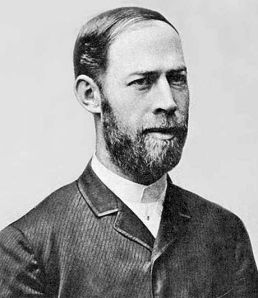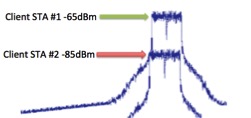One of the greatest things about working for Ruckus is that I get to work with so many smart men and women. And we have a plethora of them that are experts in radio frequency, which is why I have learned some myths that I had wrong for so many years. So it’s with that I present you some of my favorite RF Myths.
Myth #1 – Signals Interfere With Each Other
Imagine two signals from two different sources (APs for example) on the same channel colliding in mid-air. We tend to envision waves traveling through the air. And we have been told that if two signals are opposite of each other they are canceled. Well, it doesn’t work that way.
Two signals traveling through the air on the same frequency have zero effect on each other. Imagine you are holding two flashlights (torches for you English types). They both have color filters on them with one shining a blue light and the other yellow. If you shine them on the wall you see their respective colors. Now what happens if you cross the streams Does it change the colors on the wall? No, of course not. This is because they have no effect on each other as they pass through the air.
But what if you pointed both lights at the same place on the wall? The colors would mix into green. Signals don’t interfere with each other but, two or more signals that arrive at the same receiver mix and this is interference. Signals and interference are always from the perspective of the receiver. Signals traveling through the air have no effect on each other.
Myth #2 – Low Frequency Signals Travel Farther Than High Frequency
We’ve all heard that low frequency RF travels farther than high frequency but it just isn’t true. And right now you are thinking I’m crazy but hear me out.
First, picture in your head two signals of equal power traveling through space. One is a much higher frequency than the other. If they both have the same power, does it make sense that one would fizzle out before the other? This is exactly what Victor Shtrom (Ruckus co-founder) said to me. And I was like… no. That doesn’t make sense.
So let’s explore this further. If you’ve worked around RF before you KNOW that low frequencies work at farther distances. And you’d be right. Wait. Isn’t that contrary to this myth? No, there is a distinct difference. Lower frequencies have a longer effective range but it isn’t because high frequency signals get weaker faster. It’s because of something called aperture size.
The term wavelength is literally the length of one cycle of a wave. If you like math you can see it here (link to Wiki article). Frequency is just how often something happens. In this case it’s how many times a wave completes a full cycle in one second. For 2.4GHz, a wave completes a cycle 2.4 billion times per second. Sounds like our National debt. Anyway, for something like CB radio that operates at 27MHz the wave only cycles 27 million times per second. Given that all radio travels at the same speed (speed of light) the length of the wave is directly correlated to frequency. That is, the lower the frequency, the longer the wave.
Antennas are designed for a specific frequency; a specific wavelength. Many antennas are designed at ¼ wavelength intervals. Why is beyond the scope of this blog but feel free to Google antenna design to your hearts content. A 2.4GHz wavelength is just over 12cm in length. So if you design an antenna for 2.4GHz you’ll space your elements 3cm apart. If we start talking antenna gain, we look at how many of those elements there are. Generally speaking, the more elements that are lined up properly, the higher gain of the antenna. 
Let’s compare that 2.4GHz antenna to a 27MHz antenna. The wavelength at 27MHz is 11 meters. We are still going to design for ¼ wavelength so that means each ¼ wavelength is 2.75 meters long! Stay with me, we’re almost there. Let’s say we design both antennas to have 3, ¼ wavelength elements.
That means the 2.4GHz antenna is 9cm long and the 27MHz antenna is 8.25m long. So, why do lower frequencies have a longer effective range? Given the same exact design parameters, the antennas are bigger. Yes, you read it right. Lower frequency antennas are bigger. They have more surface area (aperture) to capture the signal so they hear more of the energy.
Myth #3 – Two Wi-Fi Signals Received Simultaneously Results in a Collision
Noise and interference are sometimes regarded as the same thing but they are actually quite different. Noise is signal that always exists; it even exists in nature. But interference is from an active transmitter such as a cordless phone, Bluetooth device or even Wi-Fi.
 All Wi-Fi performance is directly related to Signal to Interference + Noise Ratio (SINR). Ideally you want as much signal vs. interference as possible (to a point). When two Wi-Fi signals arrive to the client at the same time, as long as one is sufficiently stronger than the other, the stronger of the two signals will be deciphered and processed. How much stronger depends a lot on the chip itself, but if there were a 20dB difference the stronger signal would be received and deciphered perfectly. The weaker signal just gets treated as noise.
All Wi-Fi performance is directly related to Signal to Interference + Noise Ratio (SINR). Ideally you want as much signal vs. interference as possible (to a point). When two Wi-Fi signals arrive to the client at the same time, as long as one is sufficiently stronger than the other, the stronger of the two signals will be deciphered and processed. How much stronger depends a lot on the chip itself, but if there were a 20dB difference the stronger signal would be received and deciphered perfectly. The weaker signal just gets treated as noise.
In reference to myth 2. Attenuation is independent of frequency in a perfect vacuum (inverse square law). However for those of us that live on planet earth, we have to deal with absorption, which definitely does have an effect on frequency.
If you look at frequency transmitted through coax, you have a skin effect which at higher frequencies the “skin” becomes smaller and essentially reduces the cross section of the conductor (higher resistance).
I think the safer message to deliver is that lower frequency has a lower pathloss than higher frequency.
The goal of this post is to break myths that exist. If I asked 100 Wi-Fi pros about signal attenuation through free space, 98 of them would have said that high frequencies attenuate faster through free space which is of course not true.
For a person to truly understand something they need to start with a solid foundation of knowledge and understanding FSPL is one of those foundations.
I don’t disagree that people (on planet Earth) need to know that low frequencies have a higher effective range. But to ignore the basics and skip right to that is an educational mistake in my opinion.
GT
I don’t see what antenna size has to do with myth #2.
Free space loss = 36.56 + 20Log10(Frequency) + 20Log10(Distance in miles)
So… free space loss increases with frequency. So there is less signal at same distance for higher frequency.
What is the actual goal of the myth bust? Where is the benefit for the clarity?
“Lower frequencies have a longer effective range”
Isn’t this what the point of designing wifi system, for best performance at a range?
Mike, thank you for the comment.
The myth is that low frequencies travel farther. The truth is, they travel exactly the same way with the same attenuation as high frequencies. Basic signal loss is based in part on the inverse square law: http://en.wikipedia.org/wiki/Inverse-square_law. The equation for inverse square law does not include any variable for frequency because it does not matter.
However, we all know that effective ranges are frequency dependent. This is where FSPL comes in. FSPL accounts for frequency because the antenna size (aperture) http://en.wikipedia.org/wiki/Antenna_aperture is directly related to the frequency.
As the frequency gets lower, the antenna (aperture) size gets larger for the SAME antenna design. The is analogous to one person have an ear that’s twice the size of another; they will hear more b/c they have larger surface area to capture the energy.
Hope this helps. Let me know if I can explain it further.
GT
Hi GT,
I appreciate your clear explanations! I do have a question: given the “ear” is bigger for low freq vs. high freq, can you compensate for the “small ear” at high freq by using more elements, more copper, or more area in order to be equivalent to the low freq case in about the same physical size?
David,
Thank you for your comment and question. The answer is yes, you can compensate by adding more elements or “area” to receive more signal. But the advantage of high frequencies is that it allows antennas to fit in very small devices (like your phone). Plus high frequencies have more bandwidth for more available data transfer.
GT